Detailed Examination of the Australian Subclass 457 Visa Program
VerifiedAdded on 2020/03/16
|39
|11739
|50
Report
AI Summary
This report examines the Australian Subclass 457 temporary skilled work visa, designed to address labor shortages by allowing employers to sponsor skilled workers from overseas. It explores the visa's history, tracing its origins from the Keating Labor Government's initial plans and the subsequent implementation by the Howard administration. The report highlights the visa's popularity, driven by employer demand and government promotion, but also addresses significant issues, including concerns over potential exploitation of workers, wage suppression, and the impact on Australian labor market conditions. The analysis covers the application process, employer obligations, and the political controversies surrounding the visa program, including criticisms from the Australian Labor Party and the Australian Council of Trade Unions. The report further discusses the evolution of temporary migration trends in Australia and the role of the 457 visa within this context, offering a comprehensive overview of the program's impact and challenges.

Running head: SUBCLASS 457 VISA
Subclass 457 Visa
Name of the student
Name of the university
Author note
Subclass 457 Visa
Name of the student
Name of the university
Author note
Paraphrase This Document
Need a fresh take? Get an instant paraphrase of this document with our AI Paraphraser
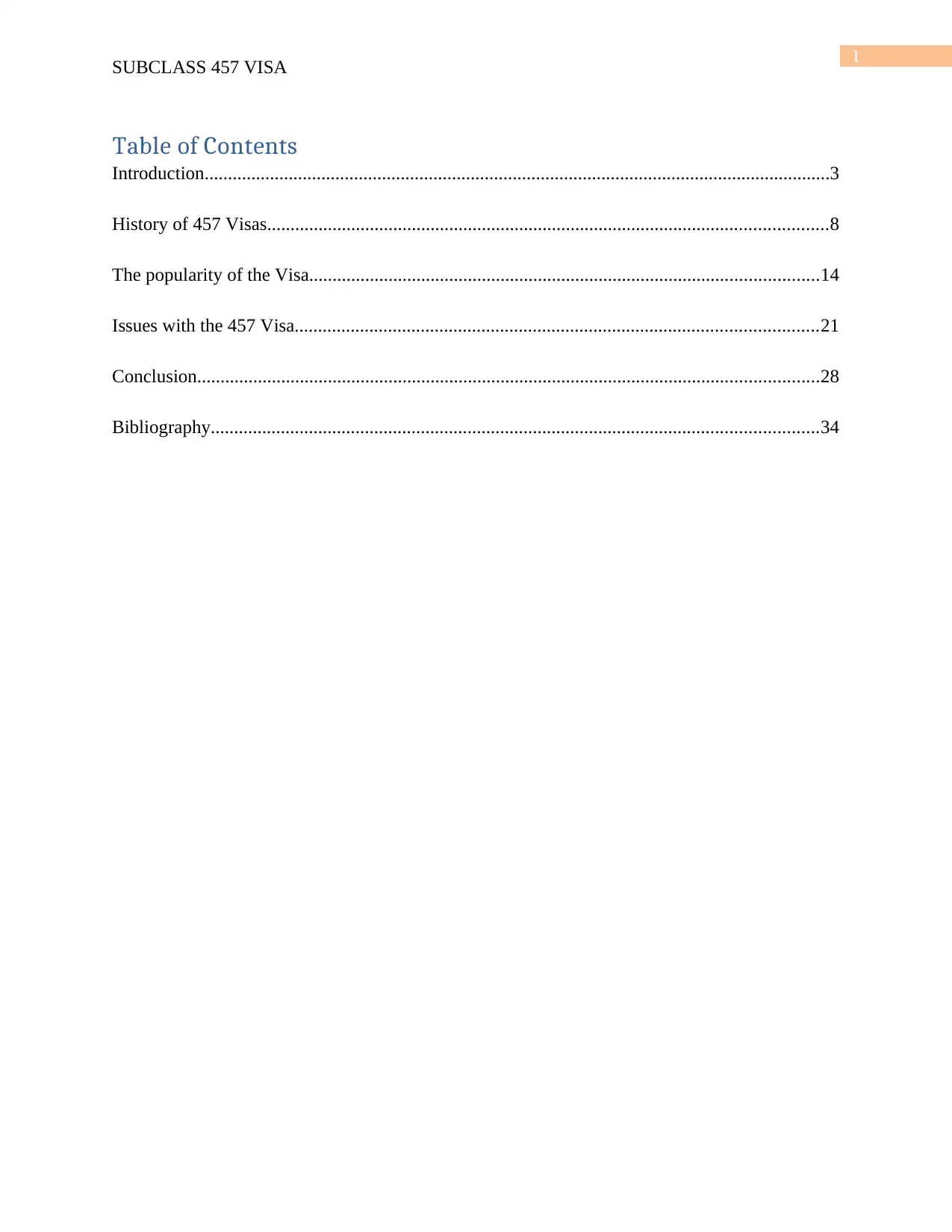
1
SUBCLASS 457 VISA
Table of Contents
Introduction......................................................................................................................................3
History of 457 Visas........................................................................................................................8
The popularity of the Visa.............................................................................................................14
Issues with the 457 Visa................................................................................................................21
Conclusion.....................................................................................................................................28
Bibliography..................................................................................................................................34
SUBCLASS 457 VISA
Table of Contents
Introduction......................................................................................................................................3
History of 457 Visas........................................................................................................................8
The popularity of the Visa.............................................................................................................14
Issues with the 457 Visa................................................................................................................21
Conclusion.....................................................................................................................................28
Bibliography..................................................................................................................................34

2
SUBCLASS 457 VISA
Introduction
The temporary business (Long stay) Visa that is the Subclass 457 temporary skilled work visa
had been designed in order to allow employers in Australia to address the issues in relation to the
shortage of labors. The visa allows such employers to bring in skilled employees from outside
Australia to meet there demands in relation to labor if such labor is not available in Australia.
There are a variety of occupations which are eligible to be granted the visa for the purpose of
work in Australia. The subclass 457 visa is the most widely used way by employers to enable a
non-resident to work in Australia by sponsoring them. With respect to the visa the employer can
sponsor the employees for a temporary period and basis. An employee can stay and work in
Australia for a period of up to four years through the use of subclass 457 visa program. The
holders of a subclass 457 visa allows are allowed to come into and go out of Australia any
number to times once they have entered the country for the first time. The visa also allows the
holder to bring into the country any of their dependents for the purpose of studying and working
in Australia1.
Oversees or Australian businesses which are not able to meet there demands with respect to
skilled employees from the labor market of Australia are able to sponsor oversee skilled
employees through the virtue of this visa program with respect to a standard business
sponsorship arrangement. The most common route towards sponsoring a prospective 457
subclass visa applicant is the standard business sponsorship arrangements2. For the purpose of
1 Larsen, Gareth. The subclass 457 visa: a quick guide. Parliamentary Library, 2013.
2 Bahn, Susanne, Llandis Barratt-Pugh, and Ghialy Yap. "The employment of skilled migrants on temporary 457
visas in Australia: Emerging issues." Labour & Industry: a journal of the social and economic relations of
work 22.4 (2012): 379-398.
SUBCLASS 457 VISA
Introduction
The temporary business (Long stay) Visa that is the Subclass 457 temporary skilled work visa
had been designed in order to allow employers in Australia to address the issues in relation to the
shortage of labors. The visa allows such employers to bring in skilled employees from outside
Australia to meet there demands in relation to labor if such labor is not available in Australia.
There are a variety of occupations which are eligible to be granted the visa for the purpose of
work in Australia. The subclass 457 visa is the most widely used way by employers to enable a
non-resident to work in Australia by sponsoring them. With respect to the visa the employer can
sponsor the employees for a temporary period and basis. An employee can stay and work in
Australia for a period of up to four years through the use of subclass 457 visa program. The
holders of a subclass 457 visa allows are allowed to come into and go out of Australia any
number to times once they have entered the country for the first time. The visa also allows the
holder to bring into the country any of their dependents for the purpose of studying and working
in Australia1.
Oversees or Australian businesses which are not able to meet there demands with respect to
skilled employees from the labor market of Australia are able to sponsor oversee skilled
employees through the virtue of this visa program with respect to a standard business
sponsorship arrangement. The most common route towards sponsoring a prospective 457
subclass visa applicant is the standard business sponsorship arrangements2. For the purpose of
1 Larsen, Gareth. The subclass 457 visa: a quick guide. Parliamentary Library, 2013.
2 Bahn, Susanne, Llandis Barratt-Pugh, and Ghialy Yap. "The employment of skilled migrants on temporary 457
visas in Australia: Emerging issues." Labour & Industry: a journal of the social and economic relations of
work 22.4 (2012): 379-398.
⊘ This is a preview!⊘
Do you want full access?
Subscribe today to unlock all pages.

Trusted by 1+ million students worldwide
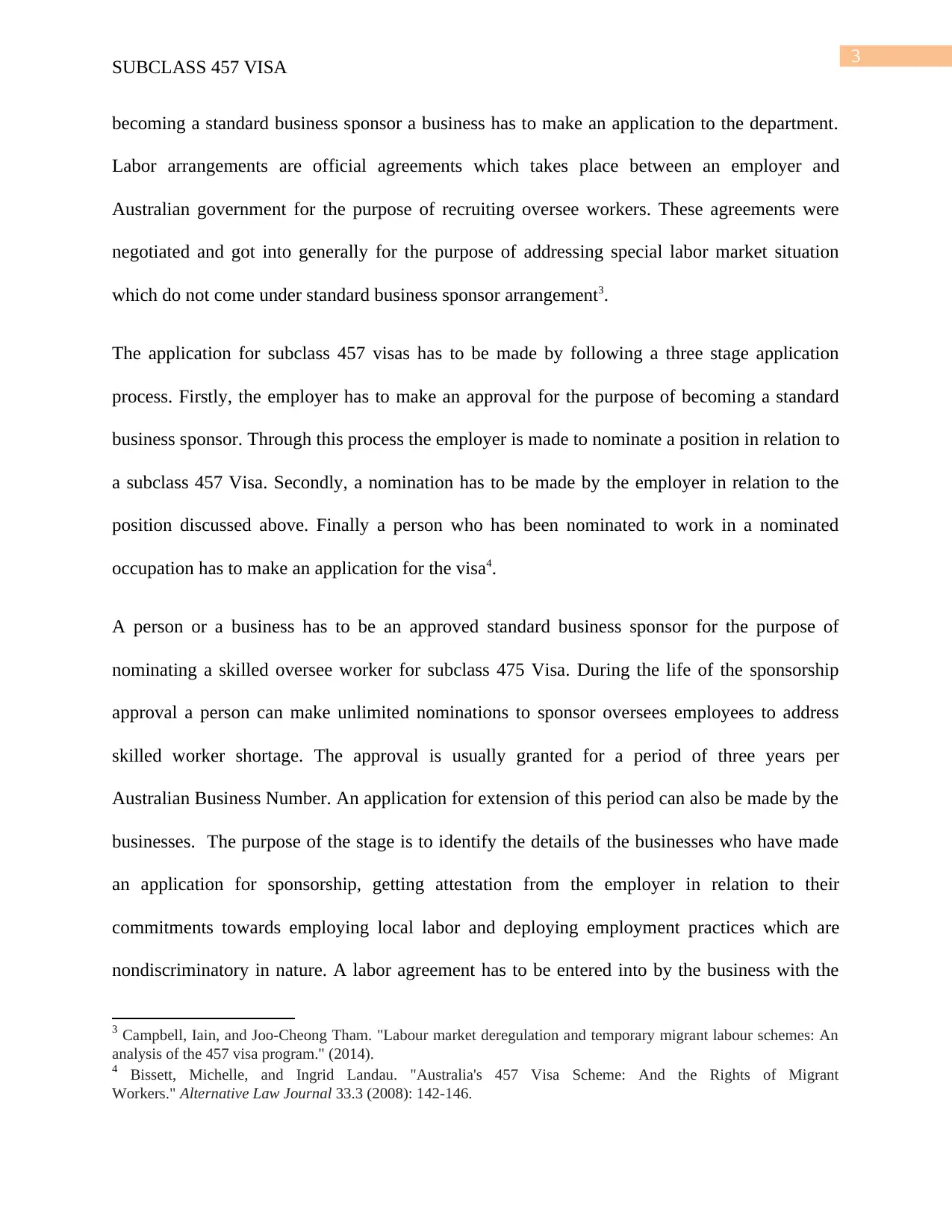
3
SUBCLASS 457 VISA
becoming a standard business sponsor a business has to make an application to the department.
Labor arrangements are official agreements which takes place between an employer and
Australian government for the purpose of recruiting oversee workers. These agreements were
negotiated and got into generally for the purpose of addressing special labor market situation
which do not come under standard business sponsor arrangement3.
The application for subclass 457 visas has to be made by following a three stage application
process. Firstly, the employer has to make an approval for the purpose of becoming a standard
business sponsor. Through this process the employer is made to nominate a position in relation to
a subclass 457 Visa. Secondly, a nomination has to be made by the employer in relation to the
position discussed above. Finally a person who has been nominated to work in a nominated
occupation has to make an application for the visa4.
A person or a business has to be an approved standard business sponsor for the purpose of
nominating a skilled oversee worker for subclass 475 Visa. During the life of the sponsorship
approval a person can make unlimited nominations to sponsor oversees employees to address
skilled worker shortage. The approval is usually granted for a period of three years per
Australian Business Number. An application for extension of this period can also be made by the
businesses. The purpose of the stage is to identify the details of the businesses who have made
an application for sponsorship, getting attestation from the employer in relation to their
commitments towards employing local labor and deploying employment practices which are
nondiscriminatory in nature. A labor agreement has to be entered into by the business with the
3 Campbell, Iain, and Joo-Cheong Tham. "Labour market deregulation and temporary migrant labour schemes: An
analysis of the 457 visa program." (2014).
4 Bissett, Michelle, and Ingrid Landau. "Australia's 457 Visa Scheme: And the Rights of Migrant
Workers." Alternative Law Journal 33.3 (2008): 142-146.
SUBCLASS 457 VISA
becoming a standard business sponsor a business has to make an application to the department.
Labor arrangements are official agreements which takes place between an employer and
Australian government for the purpose of recruiting oversee workers. These agreements were
negotiated and got into generally for the purpose of addressing special labor market situation
which do not come under standard business sponsor arrangement3.
The application for subclass 457 visas has to be made by following a three stage application
process. Firstly, the employer has to make an approval for the purpose of becoming a standard
business sponsor. Through this process the employer is made to nominate a position in relation to
a subclass 457 Visa. Secondly, a nomination has to be made by the employer in relation to the
position discussed above. Finally a person who has been nominated to work in a nominated
occupation has to make an application for the visa4.
A person or a business has to be an approved standard business sponsor for the purpose of
nominating a skilled oversee worker for subclass 475 Visa. During the life of the sponsorship
approval a person can make unlimited nominations to sponsor oversees employees to address
skilled worker shortage. The approval is usually granted for a period of three years per
Australian Business Number. An application for extension of this period can also be made by the
businesses. The purpose of the stage is to identify the details of the businesses who have made
an application for sponsorship, getting attestation from the employer in relation to their
commitments towards employing local labor and deploying employment practices which are
nondiscriminatory in nature. A labor agreement has to be entered into by the business with the
3 Campbell, Iain, and Joo-Cheong Tham. "Labour market deregulation and temporary migrant labour schemes: An
analysis of the 457 visa program." (2014).
4 Bissett, Michelle, and Ingrid Landau. "Australia's 457 Visa Scheme: And the Rights of Migrant
Workers." Alternative Law Journal 33.3 (2008): 142-146.
Paraphrase This Document
Need a fresh take? Get an instant paraphrase of this document with our AI Paraphraser
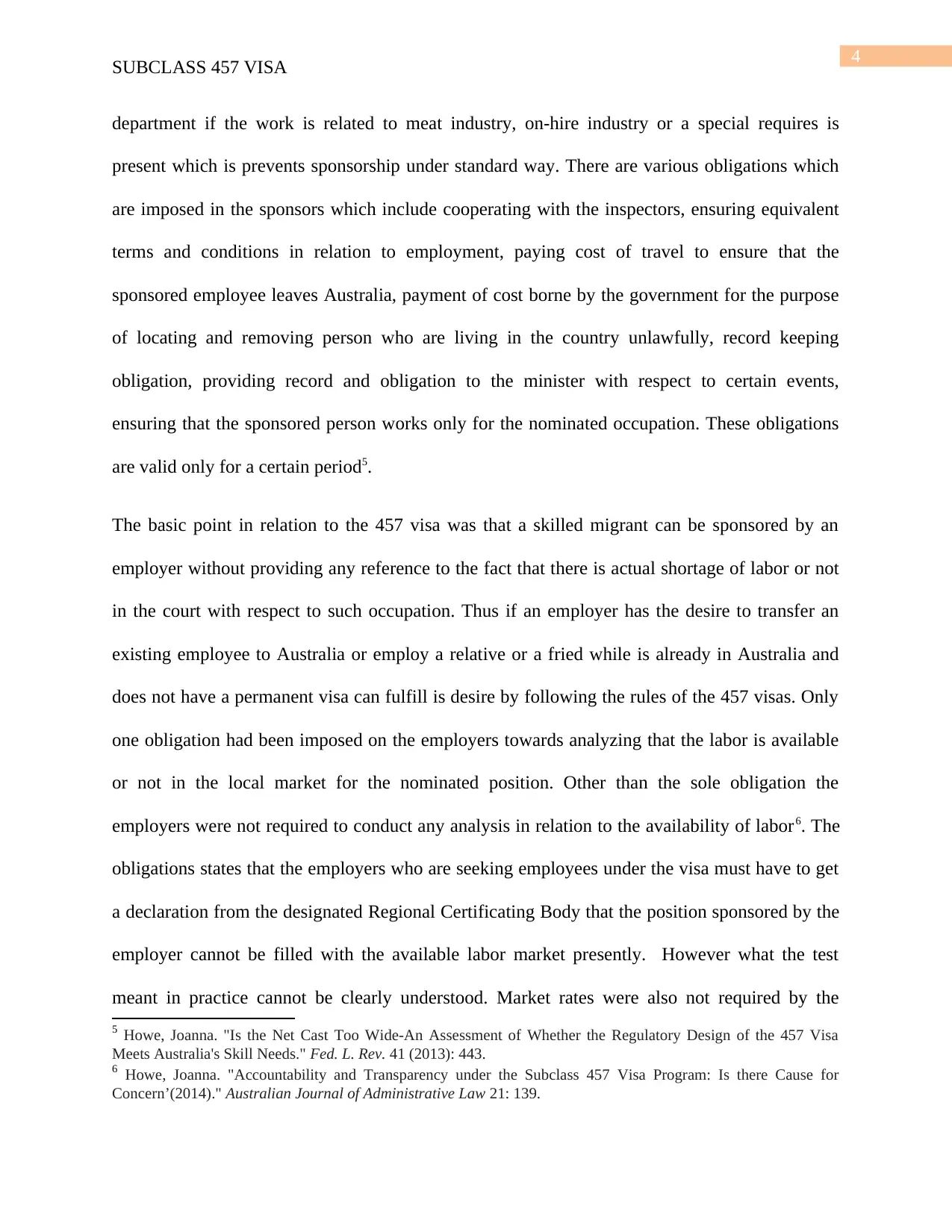
4
SUBCLASS 457 VISA
department if the work is related to meat industry, on-hire industry or a special requires is
present which is prevents sponsorship under standard way. There are various obligations which
are imposed in the sponsors which include cooperating with the inspectors, ensuring equivalent
terms and conditions in relation to employment, paying cost of travel to ensure that the
sponsored employee leaves Australia, payment of cost borne by the government for the purpose
of locating and removing person who are living in the country unlawfully, record keeping
obligation, providing record and obligation to the minister with respect to certain events,
ensuring that the sponsored person works only for the nominated occupation. These obligations
are valid only for a certain period5.
The basic point in relation to the 457 visa was that a skilled migrant can be sponsored by an
employer without providing any reference to the fact that there is actual shortage of labor or not
in the court with respect to such occupation. Thus if an employer has the desire to transfer an
existing employee to Australia or employ a relative or a fried while is already in Australia and
does not have a permanent visa can fulfill is desire by following the rules of the 457 visas. Only
one obligation had been imposed on the employers towards analyzing that the labor is available
or not in the local market for the nominated position. Other than the sole obligation the
employers were not required to conduct any analysis in relation to the availability of labor6. The
obligations states that the employers who are seeking employees under the visa must have to get
a declaration from the designated Regional Certificating Body that the position sponsored by the
employer cannot be filled with the available labor market presently. However what the test
meant in practice cannot be clearly understood. Market rates were also not required by the
5 Howe, Joanna. "Is the Net Cast Too Wide-An Assessment of Whether the Regulatory Design of the 457 Visa
Meets Australia's Skill Needs." Fed. L. Rev. 41 (2013): 443.
6 Howe, Joanna. "Accountability and Transparency under the Subclass 457 Visa Program: Is there Cause for
Concern’(2014)." Australian Journal of Administrative Law 21: 139.
SUBCLASS 457 VISA
department if the work is related to meat industry, on-hire industry or a special requires is
present which is prevents sponsorship under standard way. There are various obligations which
are imposed in the sponsors which include cooperating with the inspectors, ensuring equivalent
terms and conditions in relation to employment, paying cost of travel to ensure that the
sponsored employee leaves Australia, payment of cost borne by the government for the purpose
of locating and removing person who are living in the country unlawfully, record keeping
obligation, providing record and obligation to the minister with respect to certain events,
ensuring that the sponsored person works only for the nominated occupation. These obligations
are valid only for a certain period5.
The basic point in relation to the 457 visa was that a skilled migrant can be sponsored by an
employer without providing any reference to the fact that there is actual shortage of labor or not
in the court with respect to such occupation. Thus if an employer has the desire to transfer an
existing employee to Australia or employ a relative or a fried while is already in Australia and
does not have a permanent visa can fulfill is desire by following the rules of the 457 visas. Only
one obligation had been imposed on the employers towards analyzing that the labor is available
or not in the local market for the nominated position. Other than the sole obligation the
employers were not required to conduct any analysis in relation to the availability of labor6. The
obligations states that the employers who are seeking employees under the visa must have to get
a declaration from the designated Regional Certificating Body that the position sponsored by the
employer cannot be filled with the available labor market presently. However what the test
meant in practice cannot be clearly understood. Market rates were also not required by the
5 Howe, Joanna. "Is the Net Cast Too Wide-An Assessment of Whether the Regulatory Design of the 457 Visa
Meets Australia's Skill Needs." Fed. L. Rev. 41 (2013): 443.
6 Howe, Joanna. "Accountability and Transparency under the Subclass 457 Visa Program: Is there Cause for
Concern’(2014)." Australian Journal of Administrative Law 21: 139.

5
SUBCLASS 457 VISA
employer to be paid to the employees under the 467 visa. In both US and UK (H-1B and work
permits) there is some form of market testing applicable along with the rule of paying wages at a
market rate7.
The visa has been one of the most commonly used visa for used by non-citizens to come to
Australia for a purpose of working and enjoying holidays for a certain period which usually lasts
for more than a year on an average. The stay although limited to a period of four years can and
often is practically extended. The program provided by the subclass 457 visa is expanding in a
very rapid manner and has become a continuous and major political issue in the recent times.
The visa has now been started to be opposed in a vigorous manner by the Federal Australian
Labor Party (ALP) and the Australian Council of Trade Unions (ACTU). Both the parties
manifest the visa program as a part of broader industrial relations strategy of the coalition
government. The strategy is claimed by the critics to have been implemented in order to shift the
balance of power towards the employers with respect to working condition, shift times and
wages. It has been suspected by both the parties that the unscrupulous employers are utilizing the
program under 457 visas towards driving down working conditions and wages8. The visa also
often gets approved at a wage rate which is well below the market rate. A formal request had
been made by the ACTU for the purpose of making an investigation into the matter by the
federal ombudsman. The request was in relation to analyze whether the mandatory requires
through which the visa could be issued are met before the visa is actually issues. In addition it
was requested to analyze that the workers who are entering the country with respect to the visa
are having their rights abused or not. There was a huge increase of the number of 457 visa which
7 Hugo, Graeme, Siew-Ean Khoo, and Peter McDonald. "Attracting skilled migrants to regional areas: what does it
take?." People and Place 14.3 (2006): 26.
8 Jockel, Maria. "457 visas, skill shortages and worker protection." People and Place 17.2 (2009): 30.
SUBCLASS 457 VISA
employer to be paid to the employees under the 467 visa. In both US and UK (H-1B and work
permits) there is some form of market testing applicable along with the rule of paying wages at a
market rate7.
The visa has been one of the most commonly used visa for used by non-citizens to come to
Australia for a purpose of working and enjoying holidays for a certain period which usually lasts
for more than a year on an average. The stay although limited to a period of four years can and
often is practically extended. The program provided by the subclass 457 visa is expanding in a
very rapid manner and has become a continuous and major political issue in the recent times.
The visa has now been started to be opposed in a vigorous manner by the Federal Australian
Labor Party (ALP) and the Australian Council of Trade Unions (ACTU). Both the parties
manifest the visa program as a part of broader industrial relations strategy of the coalition
government. The strategy is claimed by the critics to have been implemented in order to shift the
balance of power towards the employers with respect to working condition, shift times and
wages. It has been suspected by both the parties that the unscrupulous employers are utilizing the
program under 457 visas towards driving down working conditions and wages8. The visa also
often gets approved at a wage rate which is well below the market rate. A formal request had
been made by the ACTU for the purpose of making an investigation into the matter by the
federal ombudsman. The request was in relation to analyze whether the mandatory requires
through which the visa could be issued are met before the visa is actually issues. In addition it
was requested to analyze that the workers who are entering the country with respect to the visa
are having their rights abused or not. There was a huge increase of the number of 457 visa which
7 Hugo, Graeme, Siew-Ean Khoo, and Peter McDonald. "Attracting skilled migrants to regional areas: what does it
take?." People and Place 14.3 (2006): 26.
8 Jockel, Maria. "457 visas, skill shortages and worker protection." People and Place 17.2 (2009): 30.
⊘ This is a preview!⊘
Do you want full access?
Subscribe today to unlock all pages.

Trusted by 1+ million students worldwide
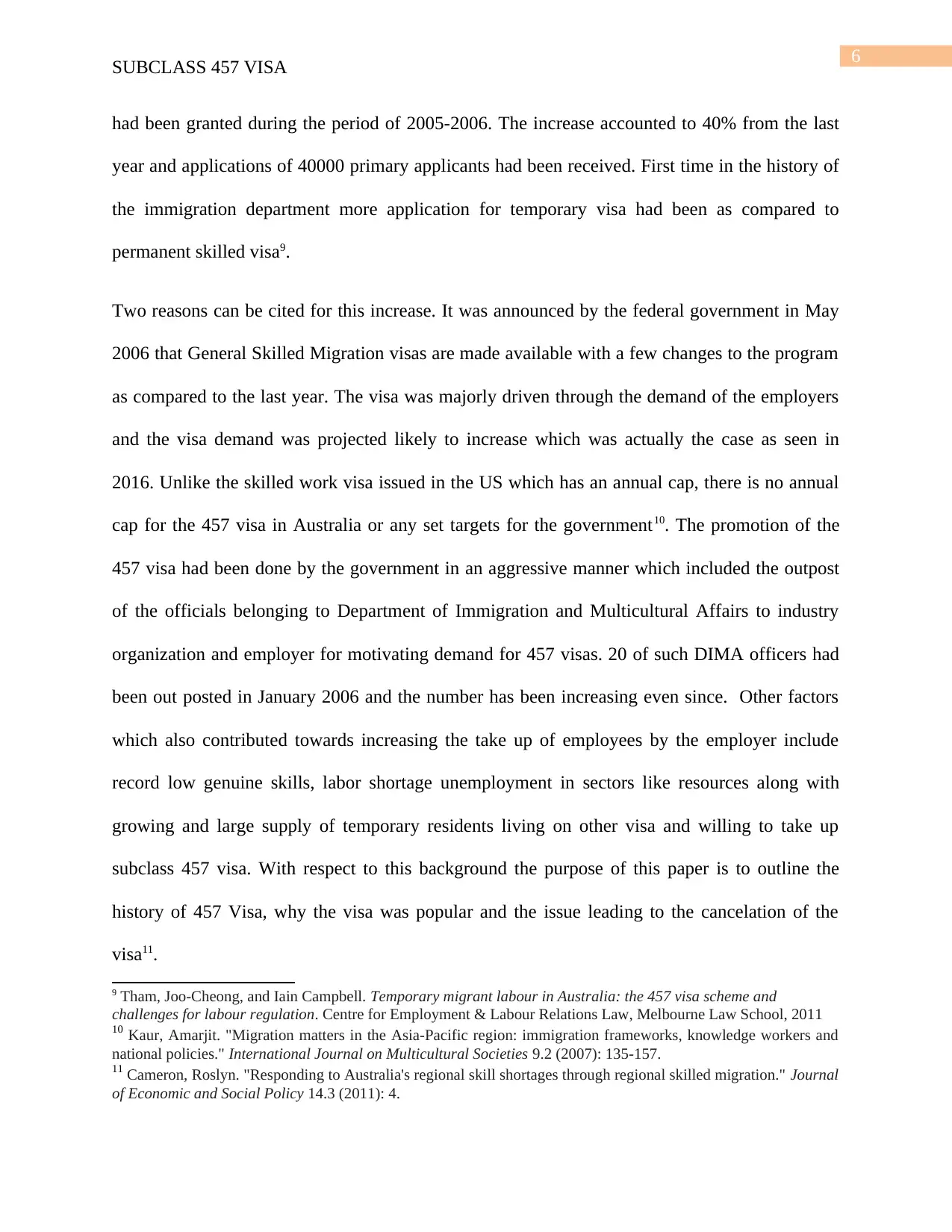
6
SUBCLASS 457 VISA
had been granted during the period of 2005-2006. The increase accounted to 40% from the last
year and applications of 40000 primary applicants had been received. First time in the history of
the immigration department more application for temporary visa had been as compared to
permanent skilled visa9.
Two reasons can be cited for this increase. It was announced by the federal government in May
2006 that General Skilled Migration visas are made available with a few changes to the program
as compared to the last year. The visa was majorly driven through the demand of the employers
and the visa demand was projected likely to increase which was actually the case as seen in
2016. Unlike the skilled work visa issued in the US which has an annual cap, there is no annual
cap for the 457 visa in Australia or any set targets for the government10. The promotion of the
457 visa had been done by the government in an aggressive manner which included the outpost
of the officials belonging to Department of Immigration and Multicultural Affairs to industry
organization and employer for motivating demand for 457 visas. 20 of such DIMA officers had
been out posted in January 2006 and the number has been increasing even since. Other factors
which also contributed towards increasing the take up of employees by the employer include
record low genuine skills, labor shortage unemployment in sectors like resources along with
growing and large supply of temporary residents living on other visa and willing to take up
subclass 457 visa. With respect to this background the purpose of this paper is to outline the
history of 457 Visa, why the visa was popular and the issue leading to the cancelation of the
visa11.
9 Tham, Joo-Cheong, and Iain Campbell. Temporary migrant labour in Australia: the 457 visa scheme and
challenges for labour regulation. Centre for Employment & Labour Relations Law, Melbourne Law School, 2011
10 Kaur, Amarjit. "Migration matters in the Asia-Pacific region: immigration frameworks, knowledge workers and
national policies." International Journal on Multicultural Societies 9.2 (2007): 135-157.
11 Cameron, Roslyn. "Responding to Australia's regional skill shortages through regional skilled migration." Journal
of Economic and Social Policy 14.3 (2011): 4.
SUBCLASS 457 VISA
had been granted during the period of 2005-2006. The increase accounted to 40% from the last
year and applications of 40000 primary applicants had been received. First time in the history of
the immigration department more application for temporary visa had been as compared to
permanent skilled visa9.
Two reasons can be cited for this increase. It was announced by the federal government in May
2006 that General Skilled Migration visas are made available with a few changes to the program
as compared to the last year. The visa was majorly driven through the demand of the employers
and the visa demand was projected likely to increase which was actually the case as seen in
2016. Unlike the skilled work visa issued in the US which has an annual cap, there is no annual
cap for the 457 visa in Australia or any set targets for the government10. The promotion of the
457 visa had been done by the government in an aggressive manner which included the outpost
of the officials belonging to Department of Immigration and Multicultural Affairs to industry
organization and employer for motivating demand for 457 visas. 20 of such DIMA officers had
been out posted in January 2006 and the number has been increasing even since. Other factors
which also contributed towards increasing the take up of employees by the employer include
record low genuine skills, labor shortage unemployment in sectors like resources along with
growing and large supply of temporary residents living on other visa and willing to take up
subclass 457 visa. With respect to this background the purpose of this paper is to outline the
history of 457 Visa, why the visa was popular and the issue leading to the cancelation of the
visa11.
9 Tham, Joo-Cheong, and Iain Campbell. Temporary migrant labour in Australia: the 457 visa scheme and
challenges for labour regulation. Centre for Employment & Labour Relations Law, Melbourne Law School, 2011
10 Kaur, Amarjit. "Migration matters in the Asia-Pacific region: immigration frameworks, knowledge workers and
national policies." International Journal on Multicultural Societies 9.2 (2007): 135-157.
11 Cameron, Roslyn. "Responding to Australia's regional skill shortages through regional skilled migration." Journal
of Economic and Social Policy 14.3 (2011): 4.
Paraphrase This Document
Need a fresh take? Get an instant paraphrase of this document with our AI Paraphraser
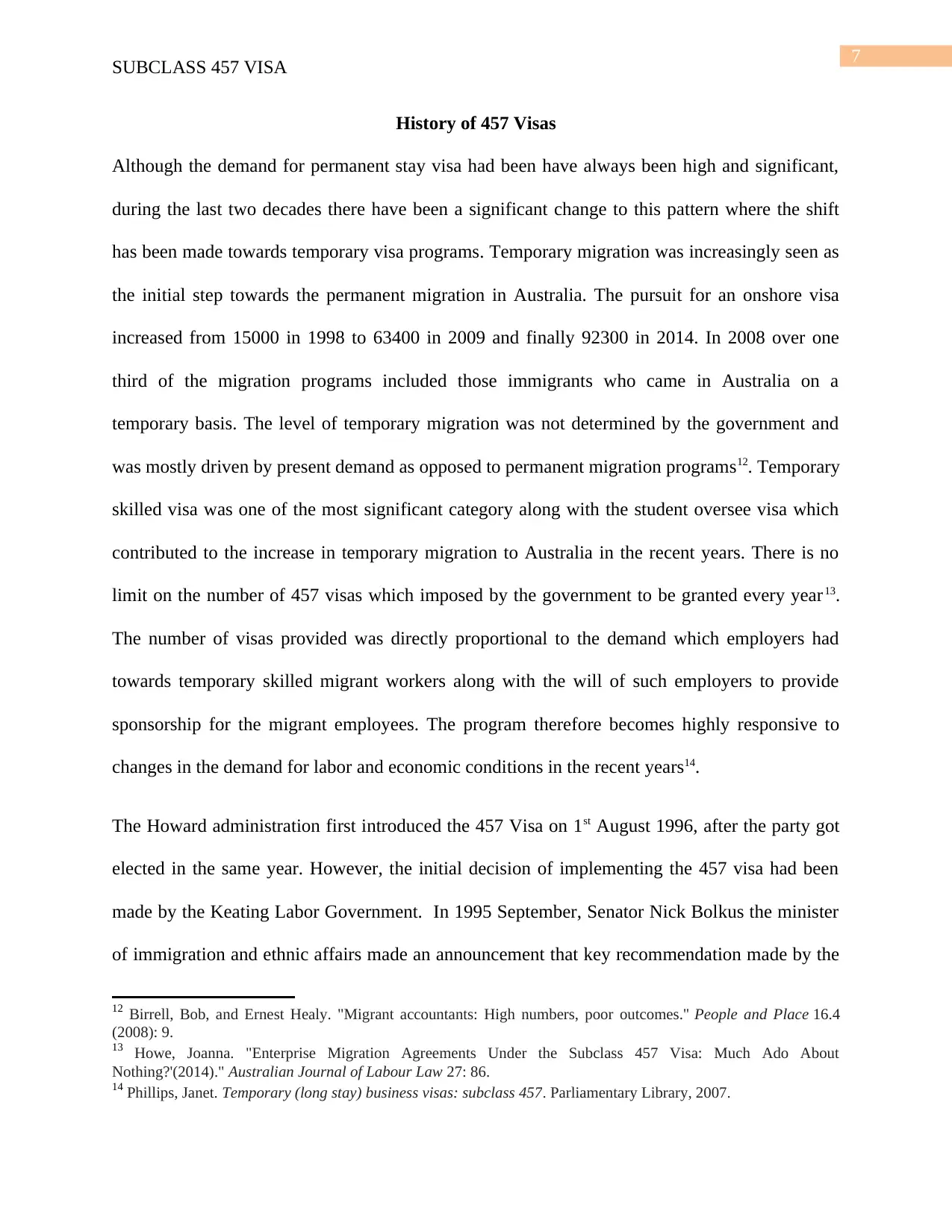
7
SUBCLASS 457 VISA
History of 457 Visas
Although the demand for permanent stay visa had been have always been high and significant,
during the last two decades there have been a significant change to this pattern where the shift
has been made towards temporary visa programs. Temporary migration was increasingly seen as
the initial step towards the permanent migration in Australia. The pursuit for an onshore visa
increased from 15000 in 1998 to 63400 in 2009 and finally 92300 in 2014. In 2008 over one
third of the migration programs included those immigrants who came in Australia on a
temporary basis. The level of temporary migration was not determined by the government and
was mostly driven by present demand as opposed to permanent migration programs12. Temporary
skilled visa was one of the most significant category along with the student oversee visa which
contributed to the increase in temporary migration to Australia in the recent years. There is no
limit on the number of 457 visas which imposed by the government to be granted every year13.
The number of visas provided was directly proportional to the demand which employers had
towards temporary skilled migrant workers along with the will of such employers to provide
sponsorship for the migrant employees. The program therefore becomes highly responsive to
changes in the demand for labor and economic conditions in the recent years14.
The Howard administration first introduced the 457 Visa on 1st August 1996, after the party got
elected in the same year. However, the initial decision of implementing the 457 visa had been
made by the Keating Labor Government. In 1995 September, Senator Nick Bolkus the minister
of immigration and ethnic affairs made an announcement that key recommendation made by the
12 Birrell, Bob, and Ernest Healy. "Migrant accountants: High numbers, poor outcomes." People and Place 16.4
(2008): 9.
13 Howe, Joanna. "Enterprise Migration Agreements Under the Subclass 457 Visa: Much Ado About
Nothing?'(2014)." Australian Journal of Labour Law 27: 86.
14 Phillips, Janet. Temporary (long stay) business visas: subclass 457. Parliamentary Library, 2007.
SUBCLASS 457 VISA
History of 457 Visas
Although the demand for permanent stay visa had been have always been high and significant,
during the last two decades there have been a significant change to this pattern where the shift
has been made towards temporary visa programs. Temporary migration was increasingly seen as
the initial step towards the permanent migration in Australia. The pursuit for an onshore visa
increased from 15000 in 1998 to 63400 in 2009 and finally 92300 in 2014. In 2008 over one
third of the migration programs included those immigrants who came in Australia on a
temporary basis. The level of temporary migration was not determined by the government and
was mostly driven by present demand as opposed to permanent migration programs12. Temporary
skilled visa was one of the most significant category along with the student oversee visa which
contributed to the increase in temporary migration to Australia in the recent years. There is no
limit on the number of 457 visas which imposed by the government to be granted every year13.
The number of visas provided was directly proportional to the demand which employers had
towards temporary skilled migrant workers along with the will of such employers to provide
sponsorship for the migrant employees. The program therefore becomes highly responsive to
changes in the demand for labor and economic conditions in the recent years14.
The Howard administration first introduced the 457 Visa on 1st August 1996, after the party got
elected in the same year. However, the initial decision of implementing the 457 visa had been
made by the Keating Labor Government. In 1995 September, Senator Nick Bolkus the minister
of immigration and ethnic affairs made an announcement that key recommendation made by the
12 Birrell, Bob, and Ernest Healy. "Migrant accountants: High numbers, poor outcomes." People and Place 16.4
(2008): 9.
13 Howe, Joanna. "Enterprise Migration Agreements Under the Subclass 457 Visa: Much Ado About
Nothing?'(2014)." Australian Journal of Labour Law 27: 86.
14 Phillips, Janet. Temporary (long stay) business visas: subclass 457. Parliamentary Library, 2007.

8
SUBCLASS 457 VISA
roach report had been accepted by the Australian government with respect to temporary skilled
visas and is set to change the programs relate to the visa in accordance to the recommendation.
These charges were actually the introduction of the new subclass 457 visa regime15. A committee
which was chaired by Neville Roach who was the Managing director of Fujitsu Australian
prepared the roach report. A representative of the ACTU had been included in the committee for
the purpose of business interest. The report was also accepted by the new coalition government
in form of a blue print for 457 Visa. A radical deregulation in relation to the temporary entry
regime of Australia had been made through the rules of 457 Visa. These also involved significant
self-regulations enacted by employers towards the recruitment of foreign nationals16. The
Australian government before august 1996 operated temporary work visa based on the principle
that the grant of visa to non citizen in relation to employment should not hamper the chances of
Australian residents to gain access to adequate jobs. The principle was thus incorporated into the
visa requirements that the employers take into account appropriate methods of local market labor
testing before nominating the position to a non-citizen. The principle and market testing signified
that an employer must demonstrate that the position to be taken by a foreign national had been
offered initially to an Australian resident and none of such resident had been found suitable for
such position17.
The principles in relation to labor testing had been parted away through the implementation of
457 visas from august 1996 with respect to various employers and skilled labor category but not
all of them. The test had been removed completely from the application of 457 visas in 2001 in
15 Birrell, Bob, and Ernest Healy. "Migrant accountants: High numbers, poor outcomes." People and Place 16.4
(2008): 9.
16 Deegan, B. "Visa Subclass 457 Integrity Review: Issues Paper 3: Integrity/Exploitation." (2008).
17 Kinnaird, Bob. "Current Issues in the Skilled Temporary Subclass 457 Visa'(2006) 14 (2)." People and Place 49:
49-50.
SUBCLASS 457 VISA
roach report had been accepted by the Australian government with respect to temporary skilled
visas and is set to change the programs relate to the visa in accordance to the recommendation.
These charges were actually the introduction of the new subclass 457 visa regime15. A committee
which was chaired by Neville Roach who was the Managing director of Fujitsu Australian
prepared the roach report. A representative of the ACTU had been included in the committee for
the purpose of business interest. The report was also accepted by the new coalition government
in form of a blue print for 457 Visa. A radical deregulation in relation to the temporary entry
regime of Australia had been made through the rules of 457 Visa. These also involved significant
self-regulations enacted by employers towards the recruitment of foreign nationals16. The
Australian government before august 1996 operated temporary work visa based on the principle
that the grant of visa to non citizen in relation to employment should not hamper the chances of
Australian residents to gain access to adequate jobs. The principle was thus incorporated into the
visa requirements that the employers take into account appropriate methods of local market labor
testing before nominating the position to a non-citizen. The principle and market testing signified
that an employer must demonstrate that the position to be taken by a foreign national had been
offered initially to an Australian resident and none of such resident had been found suitable for
such position17.
The principles in relation to labor testing had been parted away through the implementation of
457 visas from august 1996 with respect to various employers and skilled labor category but not
all of them. The test had been removed completely from the application of 457 visas in 2001 in
15 Birrell, Bob, and Ernest Healy. "Migrant accountants: High numbers, poor outcomes." People and Place 16.4
(2008): 9.
16 Deegan, B. "Visa Subclass 457 Integrity Review: Issues Paper 3: Integrity/Exploitation." (2008).
17 Kinnaird, Bob. "Current Issues in the Skilled Temporary Subclass 457 Visa'(2006) 14 (2)." People and Place 49:
49-50.
⊘ This is a preview!⊘
Do you want full access?
Subscribe today to unlock all pages.

Trusted by 1+ million students worldwide
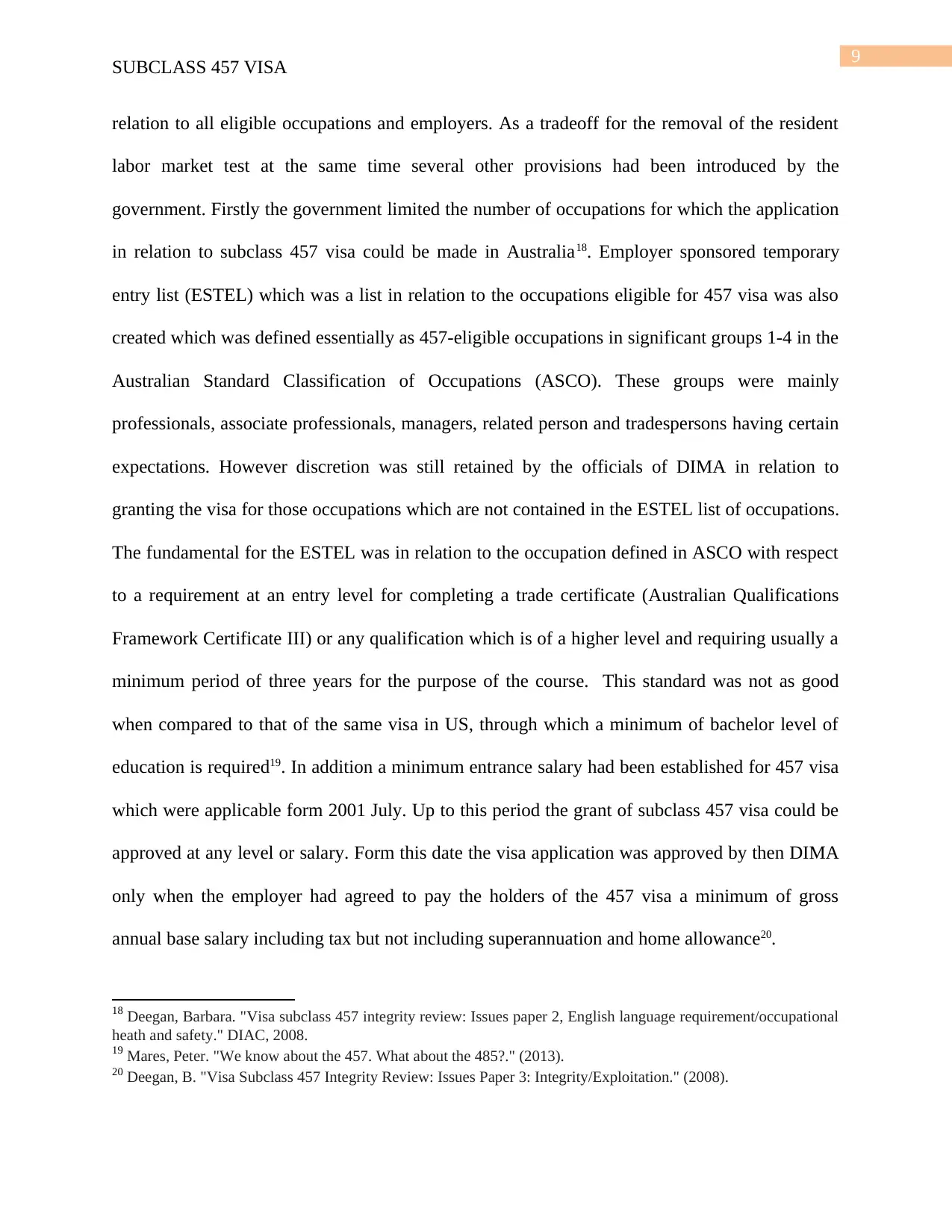
9
SUBCLASS 457 VISA
relation to all eligible occupations and employers. As a tradeoff for the removal of the resident
labor market test at the same time several other provisions had been introduced by the
government. Firstly the government limited the number of occupations for which the application
in relation to subclass 457 visa could be made in Australia18. Employer sponsored temporary
entry list (ESTEL) which was a list in relation to the occupations eligible for 457 visa was also
created which was defined essentially as 457-eligible occupations in significant groups 1-4 in the
Australian Standard Classification of Occupations (ASCO). These groups were mainly
professionals, associate professionals, managers, related person and tradespersons having certain
expectations. However discretion was still retained by the officials of DIMA in relation to
granting the visa for those occupations which are not contained in the ESTEL list of occupations.
The fundamental for the ESTEL was in relation to the occupation defined in ASCO with respect
to a requirement at an entry level for completing a trade certificate (Australian Qualifications
Framework Certificate III) or any qualification which is of a higher level and requiring usually a
minimum period of three years for the purpose of the course. This standard was not as good
when compared to that of the same visa in US, through which a minimum of bachelor level of
education is required19. In addition a minimum entrance salary had been established for 457 visa
which were applicable form 2001 July. Up to this period the grant of subclass 457 visa could be
approved at any level or salary. Form this date the visa application was approved by then DIMA
only when the employer had agreed to pay the holders of the 457 visa a minimum of gross
annual base salary including tax but not including superannuation and home allowance20.
18 Deegan, Barbara. "Visa subclass 457 integrity review: Issues paper 2, English language requirement/occupational
heath and safety." DIAC, 2008.
19 Mares, Peter. "We know about the 457. What about the 485?." (2013).
20 Deegan, B. "Visa Subclass 457 Integrity Review: Issues Paper 3: Integrity/Exploitation." (2008).
SUBCLASS 457 VISA
relation to all eligible occupations and employers. As a tradeoff for the removal of the resident
labor market test at the same time several other provisions had been introduced by the
government. Firstly the government limited the number of occupations for which the application
in relation to subclass 457 visa could be made in Australia18. Employer sponsored temporary
entry list (ESTEL) which was a list in relation to the occupations eligible for 457 visa was also
created which was defined essentially as 457-eligible occupations in significant groups 1-4 in the
Australian Standard Classification of Occupations (ASCO). These groups were mainly
professionals, associate professionals, managers, related person and tradespersons having certain
expectations. However discretion was still retained by the officials of DIMA in relation to
granting the visa for those occupations which are not contained in the ESTEL list of occupations.
The fundamental for the ESTEL was in relation to the occupation defined in ASCO with respect
to a requirement at an entry level for completing a trade certificate (Australian Qualifications
Framework Certificate III) or any qualification which is of a higher level and requiring usually a
minimum period of three years for the purpose of the course. This standard was not as good
when compared to that of the same visa in US, through which a minimum of bachelor level of
education is required19. In addition a minimum entrance salary had been established for 457 visa
which were applicable form 2001 July. Up to this period the grant of subclass 457 visa could be
approved at any level or salary. Form this date the visa application was approved by then DIMA
only when the employer had agreed to pay the holders of the 457 visa a minimum of gross
annual base salary including tax but not including superannuation and home allowance20.
18 Deegan, Barbara. "Visa subclass 457 integrity review: Issues paper 2, English language requirement/occupational
heath and safety." DIAC, 2008.
19 Mares, Peter. "We know about the 457. What about the 485?." (2013).
20 Deegan, B. "Visa Subclass 457 Integrity Review: Issues Paper 3: Integrity/Exploitation." (2008).
Paraphrase This Document
Need a fresh take? Get an instant paraphrase of this document with our AI Paraphraser
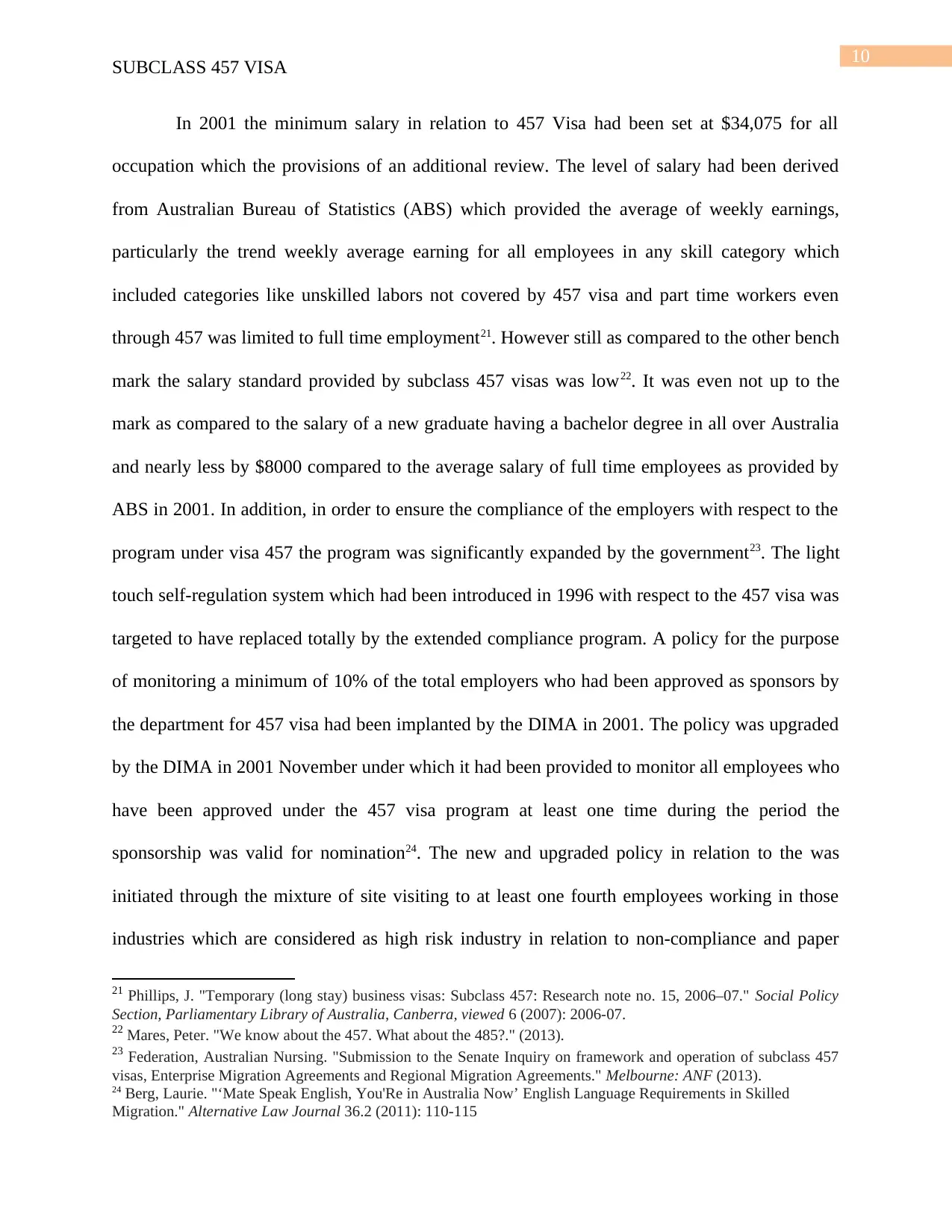
10
SUBCLASS 457 VISA
In 2001 the minimum salary in relation to 457 Visa had been set at $34,075 for all
occupation which the provisions of an additional review. The level of salary had been derived
from Australian Bureau of Statistics (ABS) which provided the average of weekly earnings,
particularly the trend weekly average earning for all employees in any skill category which
included categories like unskilled labors not covered by 457 visa and part time workers even
through 457 was limited to full time employment21. However still as compared to the other bench
mark the salary standard provided by subclass 457 visas was low22. It was even not up to the
mark as compared to the salary of a new graduate having a bachelor degree in all over Australia
and nearly less by $8000 compared to the average salary of full time employees as provided by
ABS in 2001. In addition, in order to ensure the compliance of the employers with respect to the
program under visa 457 the program was significantly expanded by the government23. The light
touch self-regulation system which had been introduced in 1996 with respect to the 457 visa was
targeted to have replaced totally by the extended compliance program. A policy for the purpose
of monitoring a minimum of 10% of the total employers who had been approved as sponsors by
the department for 457 visa had been implanted by the DIMA in 2001. The policy was upgraded
by the DIMA in 2001 November under which it had been provided to monitor all employees who
have been approved under the 457 visa program at least one time during the period the
sponsorship was valid for nomination24. The new and upgraded policy in relation to the was
initiated through the mixture of site visiting to at least one fourth employees working in those
industries which are considered as high risk industry in relation to non-compliance and paper
21 Phillips, J. "Temporary (long stay) business visas: Subclass 457: Research note no. 15, 2006–07." Social Policy
Section, Parliamentary Library of Australia, Canberra, viewed 6 (2007): 2006-07.
22 Mares, Peter. "We know about the 457. What about the 485?." (2013).
23 Federation, Australian Nursing. "Submission to the Senate Inquiry on framework and operation of subclass 457
visas, Enterprise Migration Agreements and Regional Migration Agreements." Melbourne: ANF (2013).
24 Berg, Laurie. "‘Mate Speak English, You'Re in Australia Now’ English Language Requirements in Skilled
Migration." Alternative Law Journal 36.2 (2011): 110-115
SUBCLASS 457 VISA
In 2001 the minimum salary in relation to 457 Visa had been set at $34,075 for all
occupation which the provisions of an additional review. The level of salary had been derived
from Australian Bureau of Statistics (ABS) which provided the average of weekly earnings,
particularly the trend weekly average earning for all employees in any skill category which
included categories like unskilled labors not covered by 457 visa and part time workers even
through 457 was limited to full time employment21. However still as compared to the other bench
mark the salary standard provided by subclass 457 visas was low22. It was even not up to the
mark as compared to the salary of a new graduate having a bachelor degree in all over Australia
and nearly less by $8000 compared to the average salary of full time employees as provided by
ABS in 2001. In addition, in order to ensure the compliance of the employers with respect to the
program under visa 457 the program was significantly expanded by the government23. The light
touch self-regulation system which had been introduced in 1996 with respect to the 457 visa was
targeted to have replaced totally by the extended compliance program. A policy for the purpose
of monitoring a minimum of 10% of the total employers who had been approved as sponsors by
the department for 457 visa had been implanted by the DIMA in 2001. The policy was upgraded
by the DIMA in 2001 November under which it had been provided to monitor all employees who
have been approved under the 457 visa program at least one time during the period the
sponsorship was valid for nomination24. The new and upgraded policy in relation to the was
initiated through the mixture of site visiting to at least one fourth employees working in those
industries which are considered as high risk industry in relation to non-compliance and paper
21 Phillips, J. "Temporary (long stay) business visas: Subclass 457: Research note no. 15, 2006–07." Social Policy
Section, Parliamentary Library of Australia, Canberra, viewed 6 (2007): 2006-07.
22 Mares, Peter. "We know about the 457. What about the 485?." (2013).
23 Federation, Australian Nursing. "Submission to the Senate Inquiry on framework and operation of subclass 457
visas, Enterprise Migration Agreements and Regional Migration Agreements." Melbourne: ANF (2013).
24 Berg, Laurie. "‘Mate Speak English, You'Re in Australia Now’ English Language Requirements in Skilled
Migration." Alternative Law Journal 36.2 (2011): 110-115
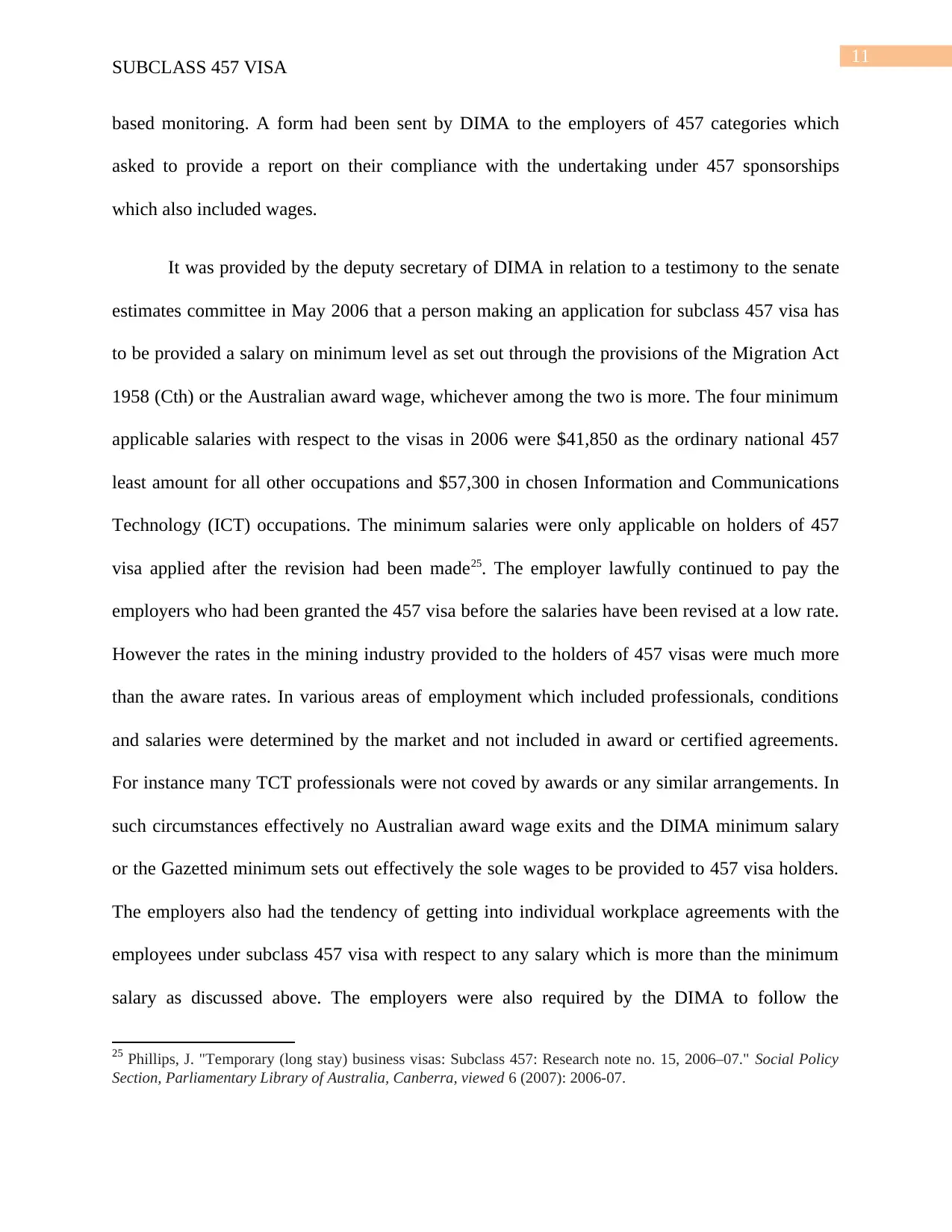
11
SUBCLASS 457 VISA
based monitoring. A form had been sent by DIMA to the employers of 457 categories which
asked to provide a report on their compliance with the undertaking under 457 sponsorships
which also included wages.
It was provided by the deputy secretary of DIMA in relation to a testimony to the senate
estimates committee in May 2006 that a person making an application for subclass 457 visa has
to be provided a salary on minimum level as set out through the provisions of the Migration Act
1958 (Cth) or the Australian award wage, whichever among the two is more. The four minimum
applicable salaries with respect to the visas in 2006 were $41,850 as the ordinary national 457
least amount for all other occupations and $57,300 in chosen Information and Communications
Technology (ICT) occupations. The minimum salaries were only applicable on holders of 457
visa applied after the revision had been made25. The employer lawfully continued to pay the
employers who had been granted the 457 visa before the salaries have been revised at a low rate.
However the rates in the mining industry provided to the holders of 457 visas were much more
than the aware rates. In various areas of employment which included professionals, conditions
and salaries were determined by the market and not included in award or certified agreements.
For instance many TCT professionals were not coved by awards or any similar arrangements. In
such circumstances effectively no Australian award wage exits and the DIMA minimum salary
or the Gazetted minimum sets out effectively the sole wages to be provided to 457 visa holders.
The employers also had the tendency of getting into individual workplace agreements with the
employees under subclass 457 visa with respect to any salary which is more than the minimum
salary as discussed above. The employers were also required by the DIMA to follow the
25 Phillips, J. "Temporary (long stay) business visas: Subclass 457: Research note no. 15, 2006–07." Social Policy
Section, Parliamentary Library of Australia, Canberra, viewed 6 (2007): 2006-07.
SUBCLASS 457 VISA
based monitoring. A form had been sent by DIMA to the employers of 457 categories which
asked to provide a report on their compliance with the undertaking under 457 sponsorships
which also included wages.
It was provided by the deputy secretary of DIMA in relation to a testimony to the senate
estimates committee in May 2006 that a person making an application for subclass 457 visa has
to be provided a salary on minimum level as set out through the provisions of the Migration Act
1958 (Cth) or the Australian award wage, whichever among the two is more. The four minimum
applicable salaries with respect to the visas in 2006 were $41,850 as the ordinary national 457
least amount for all other occupations and $57,300 in chosen Information and Communications
Technology (ICT) occupations. The minimum salaries were only applicable on holders of 457
visa applied after the revision had been made25. The employer lawfully continued to pay the
employers who had been granted the 457 visa before the salaries have been revised at a low rate.
However the rates in the mining industry provided to the holders of 457 visas were much more
than the aware rates. In various areas of employment which included professionals, conditions
and salaries were determined by the market and not included in award or certified agreements.
For instance many TCT professionals were not coved by awards or any similar arrangements. In
such circumstances effectively no Australian award wage exits and the DIMA minimum salary
or the Gazetted minimum sets out effectively the sole wages to be provided to 457 visa holders.
The employers also had the tendency of getting into individual workplace agreements with the
employees under subclass 457 visa with respect to any salary which is more than the minimum
salary as discussed above. The employers were also required by the DIMA to follow the
25 Phillips, J. "Temporary (long stay) business visas: Subclass 457: Research note no. 15, 2006–07." Social Policy
Section, Parliamentary Library of Australia, Canberra, viewed 6 (2007): 2006-07.
⊘ This is a preview!⊘
Do you want full access?
Subscribe today to unlock all pages.

Trusted by 1+ million students worldwide
1 out of 39
Related Documents
Your All-in-One AI-Powered Toolkit for Academic Success.
+13062052269
info@desklib.com
Available 24*7 on WhatsApp / Email
![[object Object]](/_next/static/media/star-bottom.7253800d.svg)
Unlock your academic potential
Copyright © 2020–2025 A2Z Services. All Rights Reserved. Developed and managed by ZUCOL.





